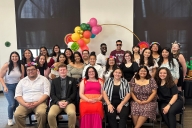You have /5 articles left.
Sign up for a free account or log in.
Summer is the time when many faculty members vacate our shared campus space and retreat to home offices (or travel) to work. Most of us are still connected to our campuses through email and some of us are teaching online. Recent debates about the value of online education and the difference between virtual and physical communities raise interesting and important questions about the importance of shared physical space.
This summer, in addition to administrating, I am teaching an online course for the second time. After almost 20 years of teaching face-to-face, I’m still getting used to online teaching. While I’m thrilled by how much easier it is to teach a well-designed online course the second time around, this summer online course feels a bit rushed—although that may be due to the compression of a summer course—and less personal. Although I made some attempts to form an online community (requiring students to complete profiles and photos), I don't feel as connected to them as I generally do with face-to-face classes; however, I know that others have achieved great success with this. I am much less comfortable making jokes and telling anecdotes in the online course and I don't find out as much about my students outside of class. But is this necessarily a bad thing? My own feelings of enjoyment and connectedness are not necessarily the most important measure of online education's effectiveness. The real question is, what are the students learning? So far, I am quite pleased with their work.
Nevertheless, despite the growth of online learning, for most students and faculty, college involves learning to claim a new physical space as “home.” As Michael Haggans’ work has shown, students often feel a great attachment to particular physical spaces on campus. They have rich sensory memories of places where they work, meet others, and participate in campus life. I’m quite nostalgic about the plaza of the Americas, a tree-lined quad designed by Frederick Olmstead on the University of Florida campus where I often sat in between classes. While the UF campus is more obviously idyllic, my college memories center on a windowed corridor hallway café at the University of Buffalo. There I could people-watch while reading, writing papers, and drinking tea. Upon reflection, I realize that both places were public, common areas where it was possible to work by oneself and still feel surrounded by people, to be a part of a common community and enjoy solitude. (Ah, the pleasure of a large state university!)
Sometimes we forget how much work it is to acclimate to a new physical space – not just for students, but for faculty as well. “Lesboprof” has a thoughtful piece on the importance of welcoming new faculty to the campus and the community. Despite how virtual colleges are becoming, for most of our new faculty, the move to our institution is involving a physical disorientation, a relocation of and rebuilding of their community.
I remember arriving at the campus of my first tenure-track job in a remote town in the Rocky Mountains. Alone and forlorn, I felt I had landed on the moon. Although I eventually made many treasured friends, for the first two years there were few social invitations. Most faculty are pretty busy and comfortable ensconced in their own social circles. Luckily, at my next position I immediately bonded with three new couples, meeting weekly for dinners, sharing information about our new community, and forming lasting friendships. But many folks aren't that lucky to have such a congenial cohort group.
As director of our teaching center, I facilitate the new faculty orientation and I’d like to address more than just the (necessary) logistics of teaching and faculty development issues. What kinds of welcoming gestures do you wish you had experienced when you started your new position?





